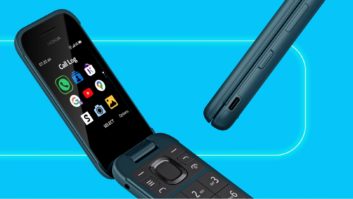“One of the most significant electronics products of the year.” That’s how the New York Times’ David Pogue describes Pure Digital’s Flip Camcorder. Of course, the Flip is actually a few years old, but whatever.
Pogue cites the company saying they have 13 percent of the camcorder market, though there’s no research firm tied to that figure. Nevertheless, it’s number one on Amazon (and Amazon’s Noah Hershman lauded the product during the TWICE Retail Roundtable). It’s even been on Oprah.
Why is the Flip a hit? Pogue says simplicity:
…the Flip has been reduced to the purest essence of video capture. You turn it on, and it’s ready to start filming in two seconds. You press the red button once to record (press hard — it’s a little balky) and once to stop. You press Play to review the video, and the Trash button to delete a clip.
There it is: the entire user’s manual.
But come on — 13 percent of the camcorder market? This limited little thing? What’s going on here? Having finally lived with the Flip, I finally know the answer: it’s a blast. It’s always ready, always with you, always trustworthy. Instead of crippling this “camcorder,” the simplicity elevates it. Comparisons with a real camcorder are nonsensical, because the Flip is something else altogether: it’s the video equivalent of a Kodak point-and-shoot camera. It’s the very definition of “less is more.”
The lesson is one that the electronics industry seems to miss over and over again: that creeping feature-itis often impairs your product instead of improving it.
I’d quibble with this a bit. It’s not that adding more features to the product impairs it so much as how features are added. Take digital cameras. Everyone says the goal of adding new features is to help people take better pictures easily. But of course, simply building better photo-taking into the camera isn’t enough – because you have to tell people you’re helping them get better pictures. After all, how else are you going to convince them to trade-up? Hence, the new picture-enhancing features have to be advertised and thrown in your face, which can ends up confusing or annoying people. A perfect example of this is how face detection puts a bracket around people’s faces on the LCD. Cool once, annoying forever after.
There is another lesson, though, in the success of the Flip. Pure Digital – the company that makes the Flip Camcorder – started with one time use digital cameras. The idea was to drive this business to retail and sell them their “imaging platform” which would process the one time use cameras and spit out the prints. They moved the concept to video in 2005, with a video recorder. The only way to get the video off the camcorder was to bring it to participating retailers to have a DVD burned.
When they introduced the Flip, they broke with the practice of making retail the exclusive way to access those videos. And look what happened – a mega hit.













